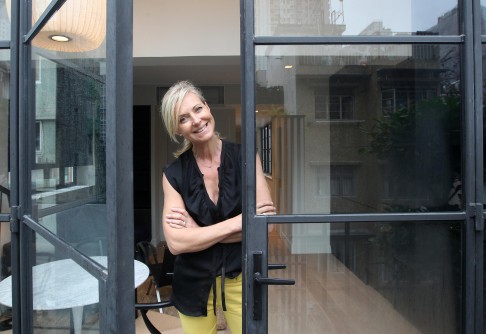Revival of Hong Kong's tong lau buildings hits many hurdles
Tenement houses have the character and charm that high-rises lack, but desperately need legal protection

Swedish designer Helen Lindman has wrought an impressive transformation of the Sheung Wan tenement building that she bought three years ago. Previously a dingy, dimly lit, six-storey walk-up, 11 Upper Station has been turned into a stylish, bright and airy residential block, comprising two duplexes and a top-floor suite.
The extensive renovations took a year to complete. Now finished, both duplexes have been rented to tenants attracted to the district by the mushrooming independent cafes and quirky shops turning it into a hip hangout.
Although their HK$79,000 monthly rental seems pricey for a tong lau, Lindman says the renovated space offers an appealing alternative to soulless high-rise apartments.
"There is definitely a demand from expats," she says. "I came to Hong Kong in 2004 and fell in love with the city's tong lau. I feel it is important to maintain them as part of Hong Kong's heritage, but they are becoming harder to find. It is too easy to bring in the bulldozer and build another high-rise. My ongoing vision is to preserve these buildings; not as monuments, but as live-in homes, reviving them, helping to revitalise the living communities in which they are set."
While Hong Kong's first tong lau emerged in the late 19th century, most were built after the mid-1950s to house a wave of post-war mainland migrants. But in Hong Kong few of these buildings remain, unlike in Macau and Singapore, which have preserved entire streets, even neighbourhoods, featuring this distinctive period architecture.
Several factors conspire against their survival, not least the absence of a comprehensive conservation policy, and banking rules that make financing of tong lau purchases - and their revival - more difficult than for other properties.
Only a handful of people have both the enthusiasm and means to revitalise the city's surviving tong lau. Most of those who do, such as Lindman and American advertising executive Dare Koslow, are expatriates.
"Westerners seem to appreciate the unique architectural style of tong lau," says Katty Law Ngar-ning, convenor of the Central and Western Concern Group. "But many Hong Kong people don't know how to preserve old buildings and would rather build a new 40-floor high-rise. They are only thinking of profit. Foreigners want to preserve things and put a lot of loving care into it."

Ten years ago the neighbourhood around Tai Ping Shan Street was quite rundown, occupied mainly by car repair and woodwork shops. "Now you're seeing galleries, cafes and bars," she says.
Lee Ho Yin, an assistant architecture professor at the University of Hong Kong, says the biggest difficulty in saving tong lau from being demolished to make way for high-rises, or from being ruined through neglect, is that most are private properties; there is little the government can do to make landlords save the buildings.
"It isn't sustainable to buy tong lau for conservation because they are designed for regular use; they are not monuments of quality, nor do they [individually] have significant architectural or historical value."
Lindman, who bought the Upper Station Street property in 2010 for HK$27 million, was fortunate to have financial help from her banker husband. But for many people loan restrictions present a significant challenge to revitalisation ventures. For residential properties worth more than HK$10 million that are not purchased for self use, the Monetary Authority requires banks to lend no more than 50 per cent of the total value.
However, institutions issuing tong lau mortgages to personal buyers will provide loans of up to 70 per cent on the condition that the sum be repaid by the time the building is 60 years old. So someone who takes out a loan for a 54-year-old tong lau has six years to pay up.
Lee, who is also director of the architectural conservation programme at HKU, says tong lau should be updated for use. An excellent example is Lui Seng Chun, a heritage shophouse in Sham Shui Po that reopened last year after a HK$28 million facelift; its upper floors are now taken up by a traditional Chinese medicine centre operated by Baptist University, with a herbal tea shop on the ground level. "When you enhance the value of the building through use, it adds heritage value to the building," Lee says.
"However, the Hong Kong development approach is high land property prices and big development ... The demolition of street blocks may give Hong Kong people the impression of development, but it is only one kind [of change]. Sars in 2003 created opportunities for [alternative] developments [when property prices crashed]."
He cites entrepreneurs Alan Lo Yeung-kit and Darrin Woo, whose design and development firm Blake's bought and modernised several tong lau properties, including TwoTwoSix on Hollywood Road.
"These developments don't involve demolition," Lee says. "We have to change people's thinking so that [renewal projects] do not just cater to big developers."
One way to retain tong lau is to restrict developments in certain areas. Not only will this moderate building prices, but also help retain the neighbourhood feel.
Lee reckons what Hong Kong needs is an army of micro developers, such as Koslow and Blake's, which seized the opportunity to buy up tong lau when property prices plunged during the Sars outbreak and fixed them up for resale or rent.
"Since the late 1970s, the policy has been geared towards big developers," he says. "But now people are seeing how big development can be destructive and it has evolved into a political and social issue."
Critics such as Katty Law blame the Urban Renewal Authority for doing little to conserve period buildings in its revitalising of older districts, but the statutory body says this is not its mandate.
The URA is "tasked to adopt redevelopment and rehabilitation as its core businesses under the Urban Renewal Strategy promulgated in 2011", its external relations department says in an e-mail.
Law says the problem is the URA doesn't have a conservation mindset - it's just focused on profit-making.
The URA's first attempt at revitalising tong lau was the former Woo Cheong Pawn Shop on Johnston Road, which reopened in 2007 after six years' restoration work.
"However, it turned into high-end restaurants causing major price increases in the neighbourhood, and now almost all the local shops have changed," Lee says.
"The use of such buildings needs to be carefully considered, because now it only benefits a few people."
Similarly, Lee Tung Street, the small Wan Chai lane that was known for its wedding card shops, has also been obliterated.
Lee believes that Hong Kong needs a fundamental change in its planning system. Well-developed cities have conservation policies under planning departments so there is controlled development. In Lee's native Singapore, policy makers introduced a conservation master plan about 30 years ago to preserve historic districts, such as Chinatown - a policy prompted in part by falling tourism numbers attributed to loss of local character in the drive to build a modern metropolis
"[Singapore] used the power of the planning authority to designate certain areas as conservation areas so they can restrict how much can be built. Hong Kong is one of the few places with a laissez-faire approach, which only benefits a few."
Planning approval processes were not introduced in Hong Kong until the 1990s, he adds. But the 2007 policy address by the then chief executive Donald Tsang Yam-kuen, which devoted eight paragraphs to heritage conservation, was a sign of growing concern about the issue.
"You need a strong government to do this [conservation]."
Nevertheless, Lee is optimistic for the future. "You are seeing property developers balanced by the voice of the people. There is hope for change by raising awareness and education. It all takes time. Hong Kong society is reaching maturity and things are starting to change."
The shift in attitude is reflected in increased numbers of postgraduate students taking up conservation courses and growing calls among young people for more culture along with environmental rights and universal rights.
"They are willing to make less money, but have more benefits to society. This is a major change in societal values."
